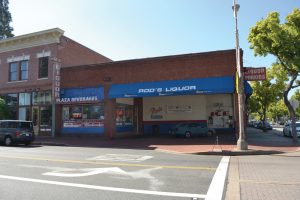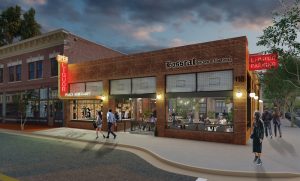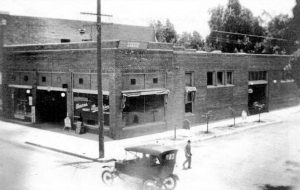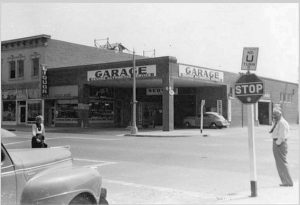— By Jeff Rabbitt and Ruba Younan —
A case study in restaurant design authenticity.
The past couple of years have been marked by a shift in restaurant design towards authentic environments that reflect their surrounding context, people and culture. Rather than just great food and service, customers are increasingly drawn to places that offer experiences, connection and history. Yet not all locations are conducive to authenticity and sites boasting a rich history are indisputably advantaged. Such is the case with the renovation of 118 W. Chapman, a century-old building located in California’s historic Old Towne Orange.
From Liquor Store to Premier Dining Destination

Jeff Rabbitt, AO
Old Towne Orange is a vibrant downtown district well-known for its antique dealers, specialty shops, art galleries and myriad restaurants. At the heart of this district sits a single-story building with a rich history and exciting future ahead. The more than 100-year-old building is currently undergoing a renaissance, transforming from a beloved neighborhood liquor store into a 5,000-square-foot, full-service restaurant. The

Ruba Younan, AO
owners of Bosscat Kitchen & Libations, a contemporary American restaurant known for its comfort food and expansive whiskey collection with locations in nearby Newport Beach and Houston, Texas, have elected this landmark to open a new location. Working closely with the city, Orange Community Historical Society, building owners and restaurant tenant, architecture firm AO crafted a design that pays homage to the roots of the building while representing the bold future of Bosscat Kitchen. Design inspiration is drawn from the prohibition-era building blended with speakeasy culture and given a modern twist to create a space that is authentic to both Old Towne Orange and Bosscat Kitchen.
Turning the Clock Back to the Building’s Origin
 The brick building at 118 W. Chapman has been a beloved landmark known as Rod’s Liquor for the past 70 years. However, from when it was first constructed in 1915 to the 1950s, the building served as an automotive garage, service station and tire store. Over the decades the building changed hands on several occasions, and the façade was altered as new businesses moved in. With the restaurant conversion ahead, new design decisions needed to be made that achieved the goals of the owner, tenant, city, historical society and other stakeholders involved. Research into the building’s history uncovered photos of the structure in the early 1920s, and all parties unanimously agreed that the next evolution of the building should turn the clock back more than 100 years to restore its original façade.
The brick building at 118 W. Chapman has been a beloved landmark known as Rod’s Liquor for the past 70 years. However, from when it was first constructed in 1915 to the 1950s, the building served as an automotive garage, service station and tire store. Over the decades the building changed hands on several occasions, and the façade was altered as new businesses moved in. With the restaurant conversion ahead, new design decisions needed to be made that achieved the goals of the owner, tenant, city, historical society and other stakeholders involved. Research into the building’s history uncovered photos of the structure in the early 1920s, and all parties unanimously agreed that the next evolution of the building should turn the clock back more than 100 years to restore its original façade.
To replicate the design of the original building, the design team relied on structural additions and renovation, restoration of historic components, utility upgrades and added functionality for future restaurant use. A key feature is an iconic covered drive-thru carved out of the building’s corner that dates back to the building’s roots as an auto repair shop, where cars previously pulled up for oil changes and service. The new design converts this corner space into what seems its destined use: an inviting dining patio and welcoming restaurant storefront.
Attention to Detail is Key to Creating a Sense of Authenticity
To create a covered dining patio and restore the building façade, a new structural column was added along with two additional window bays, both of which were designed to match the existing antique materials. The original windows and glazing are undergoing restoration and custom windows are being created to match the originals. The brick façade has undergone extensive cleaning and repair, and the new column and additions feature matching brick to seamlessly blend the old with the new.
 Workers uncovered various artifacts from the building’s former life during demolition of the interior space, including antique tools, bottles and fixtures. These objects were a source of inspiration for the interior design and will be used throughout the space. Adding to the nostalgia of the building, the existing ‘50s-era neon signage will be restored to its former glory — the neon words still ringing true for Bosscat Kitchen & Libations — “Liquor” in all caps and “Plaza Beverage.”
Workers uncovered various artifacts from the building’s former life during demolition of the interior space, including antique tools, bottles and fixtures. These objects were a source of inspiration for the interior design and will be used throughout the space. Adding to the nostalgia of the building, the existing ‘50s-era neon signage will be restored to its former glory — the neon words still ringing true for Bosscat Kitchen & Libations — “Liquor” in all caps and “Plaza Beverage.”
 Guests will enter through a recessed doorway that opens to reveal a beautiful, spacious open truss volume and skylights — a dramatic feature previously hidden behind the convenient store interior façade. The restaurant will boast a private whiskey room, whiskey reserve, library and main bar, all accented by brass fixtures, brick, antique mirrors, dark wood and a splash of rich green for a pop of color. The private whiskey room features a single large dining table and chandelier, surrounded by custom shelves and brass bird cages displaying the restaurant’s impressive whiskey collection. Flanking the whiskey room is the Library, an intimate tasting space featuring floor-to-ceiling whiskey lockers and a dark wood library ladder for functionality and character. Bosscat Kitchen is currently under construction and currently scheduled for soft opening for private events in December, with a grand opening in January 2021.
Guests will enter through a recessed doorway that opens to reveal a beautiful, spacious open truss volume and skylights — a dramatic feature previously hidden behind the convenient store interior façade. The restaurant will boast a private whiskey room, whiskey reserve, library and main bar, all accented by brass fixtures, brick, antique mirrors, dark wood and a splash of rich green for a pop of color. The private whiskey room features a single large dining table and chandelier, surrounded by custom shelves and brass bird cages displaying the restaurant’s impressive whiskey collection. Flanking the whiskey room is the Library, an intimate tasting space featuring floor-to-ceiling whiskey lockers and a dark wood library ladder for functionality and character. Bosscat Kitchen is currently under construction and currently scheduled for soft opening for private events in December, with a grand opening in January 2021.
A Key Ingredient to a Successful Renovation: Collaboration
As is the case with most historic renovations, the design team had to solve a wide range of development challenges and navigate a complex process of approvals. The keys to the project’s success were collaboration, communication, creative problem-solving and strong project management. By engaging the stakeholders early, the architects were able to capture their individual desires and guide the vision of the project towards a consensus. Great communication with the historical society was critical to understanding what could and could not be achieved from a historic renovation perspective. The design team hosted several stakeholder meetings in order to arrive at an agreed upon vision to enhance what existed, breathe new life into the building via restaurant use and extend the longevity of the structure for another century.
 Authenticity in a historic renovation cannot be achieved without a strong understanding of the building and community’s past. In this specific instance, another special ingredient was added to the recipe: a deep-rooted love for Old Towne Orange from all stakeholders involved. Headquartered in Old Towne Orange since 1974, AO was both uniquely positioned and enthusiastic to play a part in designing the next chapter of a cherished landmark.
Authenticity in a historic renovation cannot be achieved without a strong understanding of the building and community’s past. In this specific instance, another special ingredient was added to the recipe: a deep-rooted love for Old Towne Orange from all stakeholders involved. Headquartered in Old Towne Orange since 1974, AO was both uniquely positioned and enthusiastic to play a part in designing the next chapter of a cherished landmark.
— Jeff Rabbitt is partner at AO, an Orange County, California-based architectural services firm with 10 distinct design studios serving the entire commercial real estate spectrum. Rabbitt is head of AO Restaurant, a design studio he built from the ground up. In this role, he manages client relationships and works directly with design and production teams to deliver best-in-class architectural and client services. He can be reached at (714) 639-9860.
— Ruba Younan is principal at AO and design director of AO Restaurant, where she works directly with clients while managing AO’s design staff to conceptualize, develop and bring innovative, relevant design solutions to meet the client’s vision. She can be reached at (714) 639-9860.
